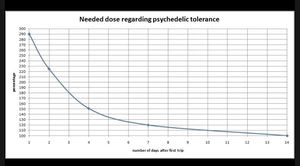LSD
LSD, or lysergic acid diethylamide, is a potent psychedelic that gained notoriety during the counterculture movement of the 1960s. It is a synthetic compound derived from ergot fungus, which grows on grains such as rye and wheat.
Like other psychedelics the effects of LSD can be unpredictable and vary widely from person to person. The drug can cause sensory distortions, altered states of consciousness, and profound alterations in perception and thought. Many users report feeling a sense of euphoria or "oneness" with the universe, while others experience terrifying and deeply disturbing hallucinations.
Pharmacology
LSD is a 5-HT2a reception agonist and dopamine receptor agonist.
Dose
The typical dose of LSD is measured in micrograms (mcg), with a standard dose ranging from 50 to 150 mcg. However, the potency of LSD can vary widely depending on the source, purity, and preparation of the drug. For this reason, it is important for users to be aware of the potency of the LSD they are using and to start with a low dose to gauge their sensitivity to the drug. At lower doses, LSD can produce mild visual distortions, such as changes in color perception, pattern recognition, and object shape. Users may also experience changes in mood, such as feelings of euphoria, relaxation, or heightened emotional sensitivity. These effects typically last for several hours, and users may feel a sense of afterglow or residual effects for several days following the experience. Higher doses of LSD can produce more intense effects, including vivid and sometimes overwhelming hallucinations, disorientation, and altered states of consciousness. Users may also experience physical symptoms, such as increased heart rate, elevated blood pressure, and changes in body temperature. At extremely high doses, LSD can lead to dangerous and potentially life-threatening effects, such as seizures, respiratory failure, and cardiac arrest.
Tolerance
Repeated use of LSD can lead to a tolerance to its effects, which means that users may need to take higher doses to achieve the same level of effects as before. After a single dose, users may experience a tolerance that lasts for several days, during which time they may need to take higher doses to achieve the same level of effects as before. With continued use, the tolerance can become more long-lasting, requiring even higher doses to achieve the desired effects (see Figure 1).
